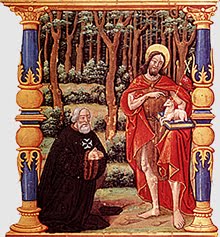Here the cross with which the Candle is solemnly signed at the beginning of the Vigil ceremony is in the form of the Maltese cross of the Order, surrounded by the chaplet, or rosary, of religious profession of the Priory. The cross symbolises our Lord's glorified and risen body which we honour and celebrate this night, in the promise of our own Resurrection and Salvation. The eight points of the Maltese cross also remind us of the eight Beatitudes, which form a code of life for all Christians, and especially for the knights of the Order, and upon which we have meditated during Lent.
The cross is surrounded by the greek letters Alpha and Omega, the first and last letters of the alphabet, also symbols of Christ, who is from before the beginning of creation, and will return to earth in judgment on the last day, and numerals of the year, 2011, to emphasise that while our destiny is eternal, we live our life of Faith in real time in this world. As the priest incises these symbols into the wax with a stylus, he says the following words: Christus heri et hodie, Principium et Finis, Alpha et Omega. Ipsius sunt tempora et saecula. Ipsi gloria et imperium per universa aeternitatis saecula. Amen. (Christ yesterday and today, the beginning and the end, Alpha and Omega. His are the times and ages. To him be glory and dominion through all the ages of eternity. Amen.)
At the centre and the four points of the cross are inserted grains of incense, set either in wax or metal containers, which symbolise the five holy wounds with which the Lord's glorified body will remain marked for all eternity. As he thrusts the pins into the soft wax, as the nails were hammered into Christ suffering body, the priest says: Per sua sancta vulnera gloriosa custodiat et conservet nos Christus Dominus. Amen. (Through his holy and glorious wounds may Christ the Lord guard and preserve us. Amen.)
A detail which cannot be seen in this photograph, the upper band bears the word Surrexit, He is risen! and at the bottom in Greek the ancient Easter greeting Χριστός ἀνέστη, CRISTOS ANESTI - Christ is risen, to which the reply is Ἀληθῶς ἀνέστη, ALITOS ANESTI - He is risen indeed. (Sorry, we cannot make the browser type Greek capitals. Ed.)
Above the sacred ritual symbols is the shield of the ancient Langue of England, which subsists today in the Grand Priory of England, and which arms are used on the banner of the Grand Priory. These arms, the ancient royal arms of England, were adopted by the English Langue during the crusades. Today the Order is the oldest body using these arms by ancient right. Below the cross are the arms of the present Grand Prior, Fra' Fredrik Crichton-Stuart, who is the Superior of the Order in this country, and thus of the religious life of the Conventual Church, which is the seat of his 'convent'. The custom of putting the arms of the diocesan bishop or religious superior is very ancient, and reminds us that we derive our Salvation not by our own merits or piety, but though the Catholic Church, her structures and Sacraments, founded by Christ at the Passover supper, and sealed by his own Precious Blood on Good Friday.
The candle will burn in the church at Masses throughout Eastertide, and be used for baptisms and funerals in the Hospital through the year.
Lumen Christi, Deo Gratias
Lumen Christi, Deo Gratias












